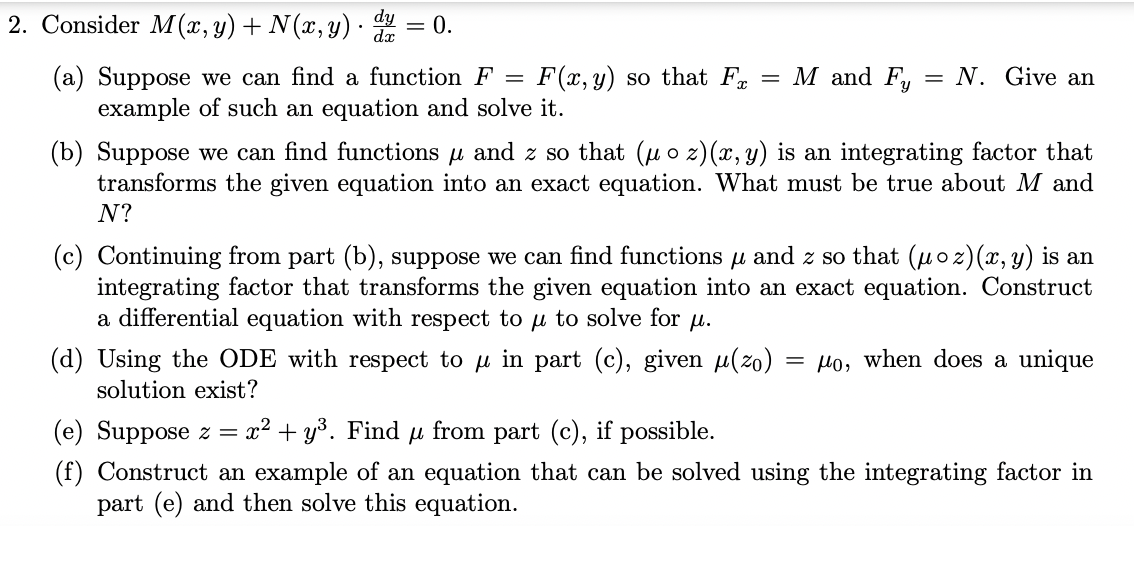(a) Suppose we can find a function F = example of such an equation and solve it. F(x, y) so that F = M and F, = N. Give an (b) Suppose we can find functions u and z so that (µo z)(x, y) is an integrating factor that transforms the given equation into an exact equation. What must be true about M and N? (c) Continuing from part (b), suppose we can find functions µ and z so that (uo z)(x, y) is an integrating factor that transforms the given equation into an exact equation. Construct a differential equation with respect to u to solve for u.
(a) Suppose we can find a function F = example of such an equation and solve it. F(x, y) so that F = M and F, = N. Give an (b) Suppose we can find functions u and z so that (µo z)(x, y) is an integrating factor that transforms the given equation into an exact equation. What must be true about M and N? (c) Continuing from part (b), suppose we can find functions µ and z so that (uo z)(x, y) is an integrating factor that transforms the given equation into an exact equation. Construct a differential equation with respect to u to solve for u.
Advanced Engineering Mathematics
10th Edition
ISBN:9780470458365
Author:Erwin Kreyszig
Publisher:Erwin Kreyszig
Chapter2: Second-order Linear Odes
Section: Chapter Questions
Problem 1RQ
Related questions
Question
Please explain each part in order as I'm totally confused. For part d I have to use the existence and uniqueness theorem

Transcribed Image Text:2. Consider M(x, y) + N(x, y) · = 0.
(a) Suppose we can find a function F
example of such an equation and solve it.
F(x, y) so that F
= M and F,:
= N. Give an
(b) Suppose we can find functions u and z so that (uo z)(x, y) is an integrating factor that
transforms the given equation into an exact equation. What must be true about M and
N?
(c) Continuing from part (b), suppose we can find functions u and z so that (uoz)(x, y) is an
integrating factor that transforms the given equation into an exact equation. Construct
a differential equation with respect to u to solve for u.
(d) Using the ODE with respect to u in part (c), given u(zo) = Ho, when does a unique
solution exist?
(e) Suppose z = x² + y³. Find u from part (c), if possible.
(f) Construct an example of an equation that can be solved using the integrating factor in
part (e) and then solve this equation.
Expert Solution
This question has been solved!
Explore an expertly crafted, step-by-step solution for a thorough understanding of key concepts.
Step by step
Solved in 3 steps with 1 images

Recommended textbooks for you

Advanced Engineering Mathematics
Advanced Math
ISBN:
9780470458365
Author:
Erwin Kreyszig
Publisher:
Wiley, John & Sons, Incorporated

Numerical Methods for Engineers
Advanced Math
ISBN:
9780073397924
Author:
Steven C. Chapra Dr., Raymond P. Canale
Publisher:
McGraw-Hill Education

Introductory Mathematics for Engineering Applicat…
Advanced Math
ISBN:
9781118141809
Author:
Nathan Klingbeil
Publisher:
WILEY

Advanced Engineering Mathematics
Advanced Math
ISBN:
9780470458365
Author:
Erwin Kreyszig
Publisher:
Wiley, John & Sons, Incorporated

Numerical Methods for Engineers
Advanced Math
ISBN:
9780073397924
Author:
Steven C. Chapra Dr., Raymond P. Canale
Publisher:
McGraw-Hill Education

Introductory Mathematics for Engineering Applicat…
Advanced Math
ISBN:
9781118141809
Author:
Nathan Klingbeil
Publisher:
WILEY

Mathematics For Machine Technology
Advanced Math
ISBN:
9781337798310
Author:
Peterson, John.
Publisher:
Cengage Learning,

